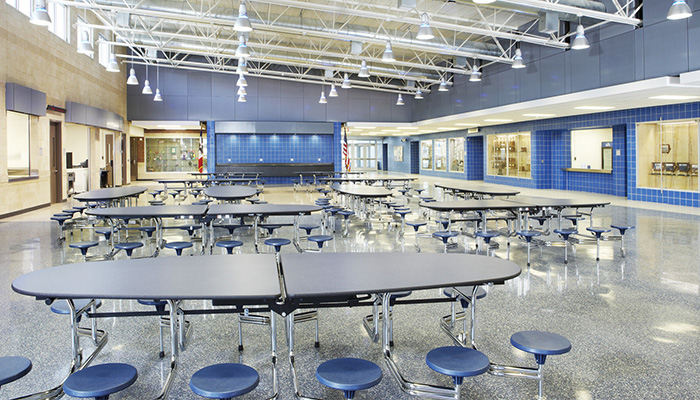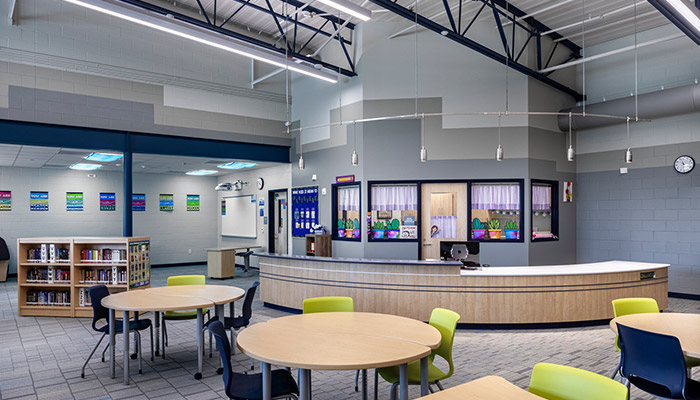
Example lunchroom

Example media room
Tornadoes can occur anywhere in the United States, but are most frequent in the tornado-prone Midwestern states. With students and staff spending a large portion of their day in the school building, having a designated safe area for use during a tornado is critical.
While tornadoes can be infrequent, Iowa and surrounding states have among the highest number of tornadoes per square mile in the United States. There is an assumption that school buildings are designed to be safe during a tornado. In fact, even if a school is built to modern day building codes, significant building damage is to be expected in the event of a tornado.
Tornadoes vary in severity from EF0 to EF5:
- Weaker EF0 to EF2 tornadoes account for 96% of all tornadoes; these tornadoes can damage most schools, but they present a lower risk to life safety than a stronger tornado.
- EF3 and stronger tornadoes can cause significant damage to a school building and have a greater risk of injury or death for building occupants.
Storm Shelters & Safe Rooms
The best option for student and staff safety is a storm shelter or safe room and should be added if an existing school building does not have one.
- Storm Shelter-Designed per the International Code Council (ICC) 500 code and is designated for use during a tornado. A good time to incorporate a storm shelter into a school is during the design of an addition to an existing building. It is usually difficult to modify existing areas to meet storm shelter design requirements in typical school construction.
- Safe Room-Similar to a storm shelter, but is designed to a different standard, FEMA P-361. A designated safe room is required if federal funding is provided by FEMA.
Storm Shelters or Safe Rooms can be costly to add to existing buildings. In the interim, the next best option is to identify the Best Available Refuge Areas (BARA) inside the existing building.
Best Available Refuge Area (BARA)-Until you Are Able to Add a Storm Shelter or Safe Room to Your Existing School
BARAs are locations in existing buildings that have been identified by a qualified engineer to offer the greatest safety potential for building occupants during a tornado. These areas were not specifically designed to withstand high wind or tornado forces and would not qualify as a storm shelter or safe room, but are the safest available areas of the existing building. While injuries are less likely, they may still occur. BARAs should be viewed as an interim measure only until a storm shelter can be made available.
How to Determine the Best Available Refuge Areas
Most schools in tornado prone regions already have identified refuge areas. These designated areas have often not been selected by a qualified engineer, and this can result in students and staff taking refuge in areas that offer less protection. The ability to tell the difference between a desirable area of refuge and a potentially dangerous one is unfortunately not straight-forward.
Partnering with a structural engineer to evaluate the BARA using the criteria recommended by FEMA is an inexpensive way for administrators to provide better safety in the event of high winds or a tornado.
Shive-Hattery design professionals can assess existing buildings to determine the BARA. The steps for a BARA assessment include:
- Gather relevant information (e.g. existing building drawings, number of building occupants, etc.)
- Using the FEMA checklist, review building drawings to determine the potential refuge areas.
- Conduct a site assessment to verify the building generally matches the construction drawings and to verify any relevant information missing from the drawings.
It is important to be prepared for natural hazards. A BARA analysis is a great first step in ensuring occupant safety during a tornadic event. Shive-Hattery will use its full-service approach to assess and determine the Best Available Refuge Areas for your students and staff.
Follow our Extreme Wind Event biweekly-series intended to help walk you through identifying vulnerabilities and opportunities to improve safety:


